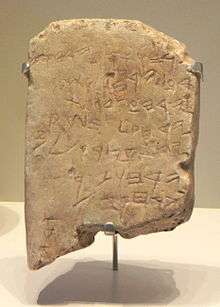Gezer calendar
|
The calendar in its current location | |
| Material | Limestone |
|---|---|
| Size | 11.1 x 7.2 cm |
| Writing | Hebrew or paleo-Hebrew |
| Created | c. 925 BCE |
| Discovered | 1908 |
| Present location | Istanbul Archaeology Museums |
| Identification | 2089 T |

The Gezer calendar is a small inscribed limestone tablet discovered in the ancient Canaanite city of Gezer, 20 miles west of Jerusalem. It is commonly dated to the 10th-century BCE, although its identification during the excavations was not in a "secure archaeological context", presenting uncertainty around the dating.[1]
Scholars are divided as to whether the language is Phoenician or Hebrew and whether the script is Phoenician (or Proto-Canaanite) or paleo-Hebrew.[2][3][4][5][6]
Inscription
The calendar is inscribed on a limestone plaque and describes monthly or bi-monthly periods and attributes to each a duty such as harvest, planting, or tending specific crops.
The inscription is in Phoenician or paleo-Hebrew script, which in equivalent square Hebrew letters is as follows:
- ירחואספ ירחוז
- רע ירחולקש
- ירחעצדפשת
- ירחקצרשערמ
- ירחקצרוכל
- ירחוזמר
- ירחקצ
- אבי (ה)
It has been translated as:
- Two months gathering (September, October)
- Two months planting (November, December)
- Two months late sowing (January, February)
- One month cutting flax (March)
- One month reaping barley (April)
- One month reaping and measuring grain (May)
- Two months pruning (June, July)
- One month summer fruit (August)[7]
Scholars have speculated that the calendar could be a schoolboy's memory exercise, the text of a popular folk song or a children's song. Another possibility is something designed for the collection of taxes from farmers.
The scribe of the calendar is probably "Abijah", which means "Yah (a shortened form of the Tetragrammaton) is my father". This name appears in the Bible for several individuals, including a king of Judah (1 Kings 14:31).
History
The calendar was discovered in 1908 by R.A.S. Macalister of the Palestine Exploration Fund while excavating the ancient Canaanite city of Gezer, 20 miles west of Jerusalem.
The Gezer calendar is currently displayed at the Museum of the Ancient Orient, a Turkish archaeology museum,[8][9] as is the Siloam inscription and other archaeological artefacts unearthed before World War I. A replica of the Gezer calendar is on display at the Israel Museum, Israel.
See also
- List of artifacts significant to the Bible
- List of ancient Near Eastern scribes
- Archaeology of Israel
References
- ↑ Aaron Demsky (2007), Reading Northwest Semitic Inscriptions, Near Eastern Archaeology 70/2. Quote: "The first thing to consider when examining an ancient inscription is whether it was discovered in context or not. It is obvious that a document purchased on the antiquities market is suspect. If it was found in an archeological site, one should note whether it was found in its primary context, as with the inscription of King Achish from Ekron, or in secondary use, as with the Tel Dan inscription. Of course texts that were found in an archaeological site, but not in a secure archaeological context present certain problems of exact dating, as with the Gezer Calendar."
- ↑ Smith, Mark S. (2002). The Early History of God: Yahweh and the other deities in ancient Israel. Wm. B. Eerdmans Publishing Co. p. 20. ISBN 978-0-8028-3972-5.
- ↑ The Calendar Tablet from Gezer, Adam L Bean, Emmanual School of Religion
- ↑ Is it “Tenable”?, Hershel Shanks, Biblical Archaeology Review
- ↑ Spelling in the Hebrew Bible: Dahood memorial lecture, By Francis I. Andersen, A. Dean Forbes, p56
- ↑ Pardee, Dennis. "A Brief Case for the Language of the ‘Gezer Calendar’ as Phoenician". Linguistic Studies in Phoenician, ed. Robert D. Holmstedt and Aaron Schade (Winona Lake): 43.
- ↑ Coogan, Michael D. (2009). A Brief Introduction to the Old Testament: The Hebrew Bible in Its Context. Oxford University Press. p. 119. ISBN 978-0199830114.
- ↑ Gezer calendar
- ↑ Istanbul Archaeological Museums, Artifacts
Further reading
- Albright, W.F. "The Gezer Calendar" in Bulletin of the American Schools of Oriental Research (BASOR). 1943. Volume 92:16–26. Original description of the find.
- Sivan, Daniel "The Gezer calendar and Northwest Semitic linguistics", Israel Exploration Journal 48,1-2 (1998) 101–105. An up-to-date linguistic analysis of this text.
- Dever, William G. “Gezer”. In The Oxford Encyclopedia of Archaeology in the Near East vol. 2, Editor in Chief Eric M. Meyers, 396–400. New York: Oxford University Press, 1997.
- Pardee, Dennis. “Gezer Calendar”. In The Oxford Encyclopedia of Archaeology in the Near East vol. 2, Editor in Chief Eric M. Meyers, 396–400. New York: Oxford University Press, 1997.
External links
| Wikimedia Commons has media related to Category:Gezer Calendar. |
- Details of the calendar including transcription and translation. Archived 4 February 2006 at the Wayback Machine
- Another translation and a picture of the calendar.
